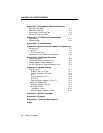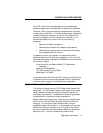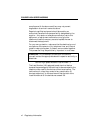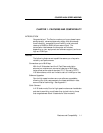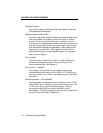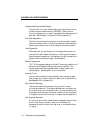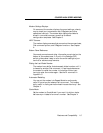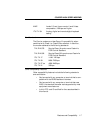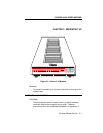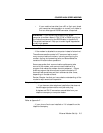
COURIER HIGH SPEED MODEMS
1-4 Features and Compatibility
Programmable Nonvolatile Memory
You can tailor your own default settings and store them in non-
volatile random access memory (NVRAM). Each time the
Courier is powered on or reset, it operates at the settings you've
specified. See Chapter 4, Appendix B, and Appendix C.
Link Rate Negotiation
The Courier automatically lowers its link rate to match a lower
rate of a remote modem, in both Originate and Answer Modes,
allowing connections with a wide range of installed modems.
Link Diagnostics
After each call, you can display a Link Diagnostics screen con-
taining information about the last call, including the number of
data characters transferred, line statistics, the call's rate and the
reason the call was disconnected. See Chapter 6.
Modem Diagnostics
ITU-T V.54 loopback testing with the &T command options, and
earlier Courier Register S16 test options are available. The
modem performs three loopback tests: analog, digital, and
remote digital. See Appendix H for information.
Inactivity Timer
You can set the modem to automatically hang up after a speci-
fied number of minutes if there is no activity on the phone line.
See Register S19 in Appendix B.
Call Duration Reporting
The modem records the duration of your calls in hours,
minutes, and seconds. This feature enables you to display and
print an audit of your calling activities. You can optionally use
the modem clock as a real-time clock. See the I3 and I6 screens
in Chapter 6 and the K command in Chapter 4 and Appendix C.
Call Progress Detection
An optional set of result codes (screen messages) lets you know
when a line is busy, a person rather than a modem has
answered the phone, there is no dial tone, or the distant phone
is ringing.



